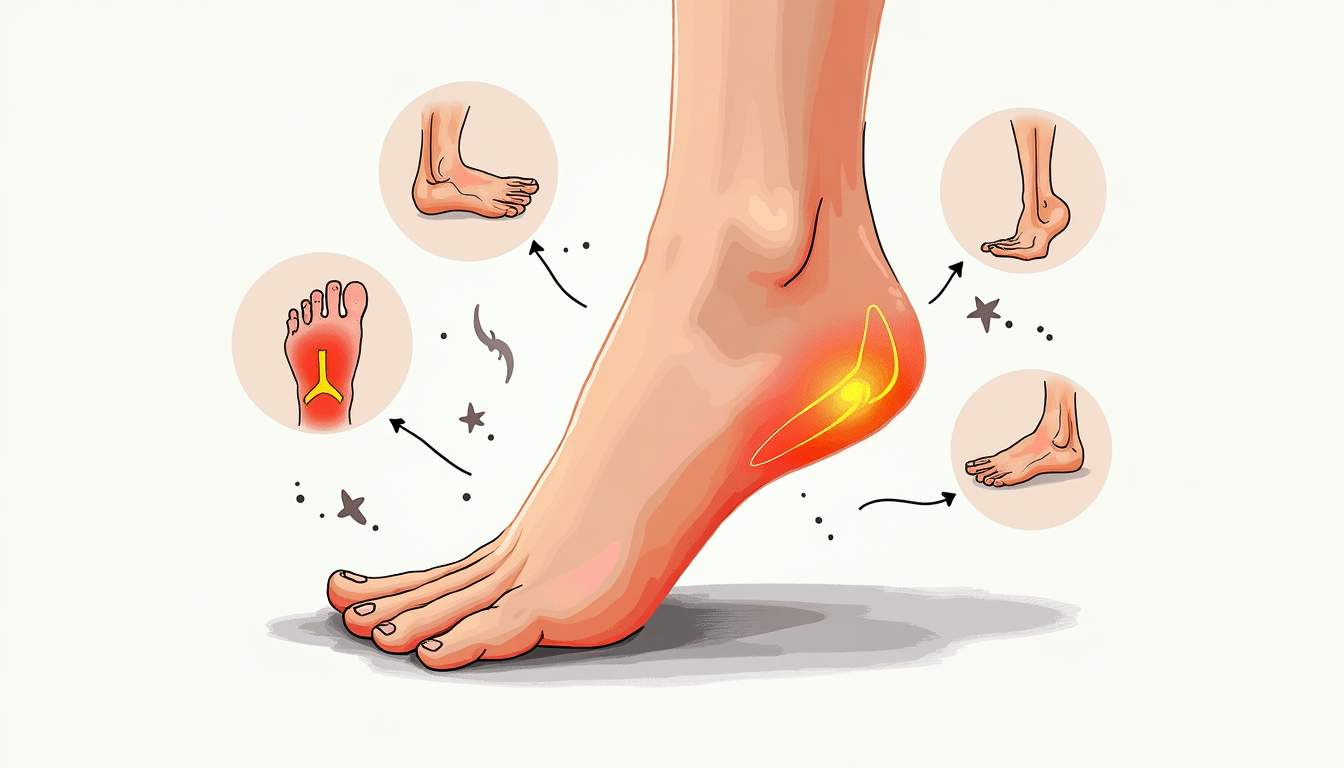
Heel pain can sneak up on anyone-whether after a long day on your feet, a sudden increase in activity, or simply waking up with a sharp discomfort that makes the first step unbearable. For many, this pain is more than just a minor annoyance; it’s a signal from the body that something needs attention. Plantar fasciitis, one of the most common causes of heel pain, affects millions and often disrupts daily routines.
Understanding the root cause of heel pain and knowing when to seek expert care can make all the difference. Here’s a detailed look at plantar fasciitis, how it impacts everyday life, and what expert treatment options are available to help you get back on your feet-literally.
What Exactly Is Plantar Fasciitis?
The Anatomy Behind the Ache
The plantar fascia is a thick band of tissue that runs along the bottom of the foot, connecting the heel bone to the toes. Its job is to support the arch of the foot and absorb the shock from walking and running. This crucial structure plays a significant role in maintaining balance and stability during movement, making it essential for everyday activities.

When this band becomes irritated or inflamed, it results in plantar fasciitis. The pain is typically sharp and localized around the heel, especially noticeable with the first steps after waking up or after sitting for extended periods. This initial pain can be so intense that it may cause individuals to alter their gait, leading to further complications in the feet and legs.
Why Does It Happen?
Plantar fasciitis doesn’t discriminate—it can affect athletes, office workers, parents constantly on the go, and seniors alike. The causes are often related to repetitive strain or excessive pressure on the plantar fascia. Understanding the underlying factors can help in both prevention and treatment.
Common contributors include:
- Overuse from running, walking, or standing for long hours
- Poor footwear lacking proper arch support
- Obesity, which increases the load on the feet
- Biomechanical issues such as flat feet or high arches
- Sudden changes in activity levels or intensity
Ignoring the pain or continuing activities without addressing the cause can lead to chronic discomfort and even changes in walking patterns that affect other joints. This can create a cascading effect, leading to pain in the knees, hips, and lower back as the body compensates for the discomfort in the feet. Furthermore, the psychological impact of chronic pain can lead to decreased activity levels, potentially resulting in weight gain and a decline in overall health.
Additionally, certain occupations that require prolonged standing or walking on hard surfaces can exacerbate the risk of developing plantar fasciitis. For instance, teachers, healthcare workers, and retail employees may find themselves particularly susceptible due to the nature of their jobs. It’s essential for individuals in these roles to invest in supportive footwear and take regular breaks to relieve pressure on their feet. Incorporating stretching and strengthening exercises into their daily routine can also be beneficial in mitigating the risk of this painful condition. For expert guidance and treatment options, you can visit Advanced Pain Relief Clinic MK.
Recognizing the Signs Early
When Heel Pain Is More Than Just a Soreness
It’s easy to dismiss heel pain as something minor that will go away on its own. But plantar fasciitis has some telltale signs that shouldn’t be overlooked:

- Sharp heel pain first thing in the morning or after rest
- Pain that worsens after prolonged standing or activity
- Stiffness and tenderness along the bottom of the foot
- Difficulty walking or bearing weight comfortably
If these symptoms persist for more than a week or two, it’s time to consider professional evaluation. Early intervention can prevent the condition from worsening and reduce the risk of long-term damage.
In addition to these signs, individuals may also notice a gradual increase in discomfort during physical activities, such as running or walking. This escalation can be particularly concerning for athletes or those with active lifestyles, as it may limit their ability to perform daily tasks or engage in their favorite sports. Ignoring these early warning signs can lead to compensatory movements, which may create additional strain on other parts of the body, such as the knees or hips, further complicating the situation.
Distinguishing Plantar Fasciitis from Other Conditions
Heel pain can stem from various sources, including heel spurs, Achilles tendonitis, bursitis, or nerve entrapment. A healthcare professional will typically perform a thorough physical examination, ask about your activity levels and footwear, and may order imaging tests to confirm the diagnosis.
Getting an accurate diagnosis ensures that treatment targets the right problem, speeding up recovery and preventing unnecessary discomfort. Understanding the nuances of these conditions is crucial, as symptoms can often overlap. For instance, heel spurs may present with similar pain but are often associated with a bony growth that can be seen on X-rays. Conversely, Achilles tendonitis may manifest as pain along the back of the heel, particularly during activities that involve running or jumping. A detailed assessment by a specialist can help clarify these distinctions and guide an effective treatment plan tailored to the individual’s needs.
Expert Approaches to Treatment
Conservative Care: The First Line of Defense
Most cases of plantar fasciitis respond well to non-invasive treatments. These methods aim to reduce inflammation, relieve pain, and support the foot’s structure. The goal is to restore normal function and allow individuals to return to their daily activities without discomfort.
Common conservative treatments include:
- Rest and Activity Modification: Reducing activities that aggravate the condition allows the tissue to heal. This may involve taking breaks from high-impact sports or activities that put excessive strain on the feet.
- Stretching Exercises: Targeted stretches for the plantar fascia and calf muscles can improve flexibility and reduce tension. Incorporating exercises such as the towel stretch or calf raises can be particularly beneficial.
- Footwear Adjustments: Wearing shoes with good arch support and cushioning is crucial. Avoid walking barefoot on hard surfaces, as this can exacerbate symptoms. It’s advisable to seek out shoes specifically designed for your foot type and activity level.
- Orthotic Devices: Custom or over-the-counter inserts can provide additional arch support and redistribute pressure. These devices help in correcting biomechanical issues that contribute to plantar fasciitis.
- Ice Therapy: Applying ice to the heel can reduce inflammation and numb pain. It’s often recommended to ice the affected area for 15-20 minutes several times a day, especially after activities.
- Nonsteroidal Anti-Inflammatory Drugs (NSAIDs): These medications can help manage pain and swelling. However, it’s important to use them as directed and consult a healthcare provider if symptoms persist.
Consistency with these treatments over several weeks often leads to significant improvement. Many patients find that integrating these approaches into their daily routine not only alleviates pain but also enhances overall foot health.
When to Consider Advanced Treatments
If symptoms persist despite conservative care, experts might recommend additional interventions. It’s essential to monitor the condition closely, as early intervention can prevent further complications and facilitate a quicker recovery.
- Physical Therapy: A therapist can provide specialized treatments and exercises to improve foot mechanics and strength. This may include modalities such as ultrasound therapy or manual manipulation to enhance healing.
- Corticosteroid Injections: These can reduce inflammation but are typically used sparingly due to potential side effects. They may provide temporary relief, allowing patients to engage more fully in physical therapy.
- Extracorporeal Shock Wave Therapy (ESWT): This non-invasive procedure uses sound waves to stimulate healing in the plantar fascia. Studies have shown promising results in reducing pain and improving function for many patients.
- Night Splints: Wearing a splint during sleep keeps the foot in a flexed position, gently stretching the fascia. This can be particularly effective in preventing morning pain, a common complaint among those suffering from plantar fasciitis.
In rare cases where pain is severe and unresponsive to other treatments, surgical options may be explored. Surgery aims to release the tight fascia and relieve pressure but is generally considered a last resort. Patients should have a thorough discussion with their healthcare provider about the risks and benefits of surgical intervention, as well as the potential for a lengthy recovery period post-surgery. Understanding all available options ensures that individuals can make informed decisions about their treatment paths.
Integrating Heel Pain Management into Daily Life
Simple Habits That Make a Difference
Living with plantar fasciitis doesn’t mean giving up on your favorite activities. Small changes can help manage symptoms and prevent flare-ups:
- Choose Supportive Footwear: Invest in shoes designed for your foot type and avoid worn-out soles.
- Take Breaks: If your job requires standing, try to sit or shift weight periodically.
- Maintain a Healthy Weight: Reducing excess pounds lessens the strain on your feet.
- Incorporate Stretching: Regularly stretch calves and feet, especially before and after exercise.
- Use Ice Packs: Apply ice after prolonged activity to soothe inflammation.
When to Seek Expert Help Again
Even after symptoms improve, plantar fasciitis can return if underlying issues aren’t addressed. Follow-up with a specialist ensures that progress continues and that any new concerns are promptly managed.
Pay attention to recurring pain, changes in foot shape, or difficulty walking. Early consultation can prevent setbacks and maintain your quality of life.
The Role of Prevention in Long-Term Foot Health
Building Resilience in Your Feet
Prevention is often the best strategy. Strengthening and conditioning your feet can protect against plantar fasciitis and other foot problems.

Consider incorporating these practices:
- Foot Strengthening Exercises: Toe curls, picking up small objects with your toes, and towel scrunches build muscle support.
- Gradual Activity Increases: Avoid sudden spikes in exercise intensity or duration.
- Regular Foot Assessments: Periodic check-ups with a podiatrist can catch issues early.
Choosing the Right Support
Custom orthotics or professionally fitted shoes can make a big difference, especially if you have biomechanical abnormalities. An expert can analyze your gait and recommend the best options tailored to your needs.
Investing in proper foot care pays off in comfort, mobility, and overall well-being.
Final Thoughts
Heel pain and plantar fasciitis can disrupt everyday life, but they don’t have to. Recognizing the symptoms early and seeking expert attention can lead to effective treatment and lasting relief. By combining professional care with smart lifestyle choices, it’s possible to keep your feet healthy and pain-free.
Don’t let heel pain hold you back. Take action, listen to your body, and consult with healthcare professionals who specialize in foot health. Your feet carry you through life-give them the care they deserve.


